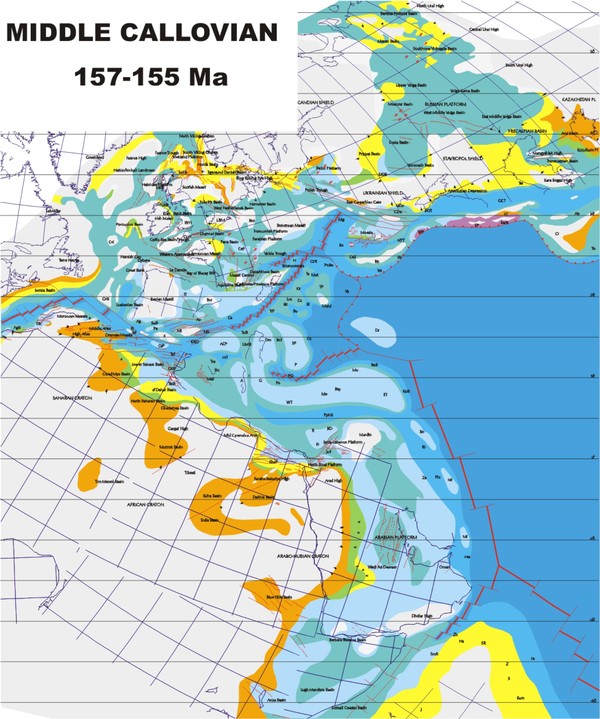The Thermal Subsidence Stage of the Margin
The subsidence driven by the tectonic extension of the rifting was gradually over, and since the Bajocian for the remaining Jurassic and the initial part of the Cretaceous the subsidence seems to be driven by the thermal cooling of the margin crust of Adria. The rifting of the Central Atlantic was gradually replaced by the drifting. The same occurred out of the Adria margin, giving birth to the Ligurian-Piedmont Ocean, a branch linking the Atlantic with the Tethys (Fig. 51). According to Bertotti et al. (1993) the W-E section from Canavese to the eastern tip of the Trento Plateau stirred from 237 km to 290 km, because of the extension. Because of the continuous deepening, the shallow-water carbonate factories moved away from the Lombardian Basin. Also on the Trento Plateau reduced productivity is recorded. The Belluno Basin instead continued to be fed by sediment-transferring processes from the Friuli Platform, which remained in a shallow-water condition.
The Lombardian Basin entered therefore into a phase of pronounced starvation, enhanced by the subsidence that brought the bottom below the Carbonate Compensation Depth (CCD) (Fig. 52). The carbonate biogenic rain was dissolved, as evidenced by the red, marly shale veneer, carpeting the top of the previous formations in the troughs (Erba and Gaetani, 1990; Erba and Casellato, 2010). This trend should have continued for a long time, if a massive input of siliceous mud had not changed the sedimentation dramatically. Following Winterer and Bosellini (1981), it was considered that the siliceous sedimentation dominating for about 20 My, from the late Bajocian to the Kimmeridgian (Baumgartner, 1987; Baumgartner et al., 1995) was the residual deposit under the CCD. Winterer (1998), reviewing the paleodepths in the Mediterraneam Jurassic, stated that radiolarian cherts are the product of massive bioproductivity. Muttoni et al. (2005) pointed out that, as today, the siliceous muds in the oceanic waters should be preserved only in the equatorial upwellings because of overproduction. Palaeomagnetics performed in the Selcifero Group of central Lombardy showed that the margin of Adria, following the loop of Africa with a southwards rotation of some 10°, was once more about 10°N latitude during the Middle Jurassic, in the more favourable conditions for massive bioproductivity of radiolarians (Muttoni et al., 2005).
Figure 52. The Jurassic succession in Lombardy.
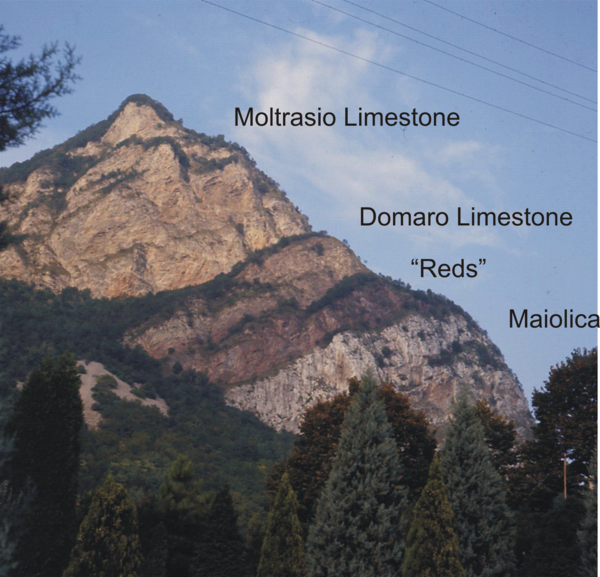
In the overturned section of M. Mudarga (western side of the Albenza Plateau) almost all the Jurassic succession is exposed. The upper part of the Moltrasio Limestone (Sinemurian-lower Pliensbachian) is followed by the Domaro Limestone (upper Pliensbachian till very base of Toarcian). The “reds” includes the Rosso Ammonitico Lombardo and the Selcifero Group (Toarcian – lower Tithonian). The Maiolica Fm. extends from the upper Tithonian to the Barremian. (Photo M. Gaetani).
From the Kimmeridgian upwards, the amount of carbonate fraction in the sediments gradually increased. Most typical is the Rosso ad Aptici Fm., in which only the originally calcitic gnawings of ammonites are preserved and not their aragonitic shells. This was traditionally interpreted as the gradual deepening of the CCD (Gaetani, 1975; Winterer and Bosellini, 1981). Muttoni et al. (2005) instead showed that the return toward more high latitudes of Adria brought the margin toward trofic conditions more favourable to the calcareous than to the siliceous phytoplankton. Bottom positive movements or significant changing of the CCD should thus not be responsible for the recovery of the carbonatic sedimentation, but rather the latitudinal moving of plates, controlling bioproductivity. The full recovery occurred with the upper Tithonian, when the whitish, well-layered mudstone of the Maiolica Fm. spread over the whole Lombardian Basin (Chiari et al., 2007; Casellato, 2010) (Fig. 53).
Figure 53. Maiolica cherts.
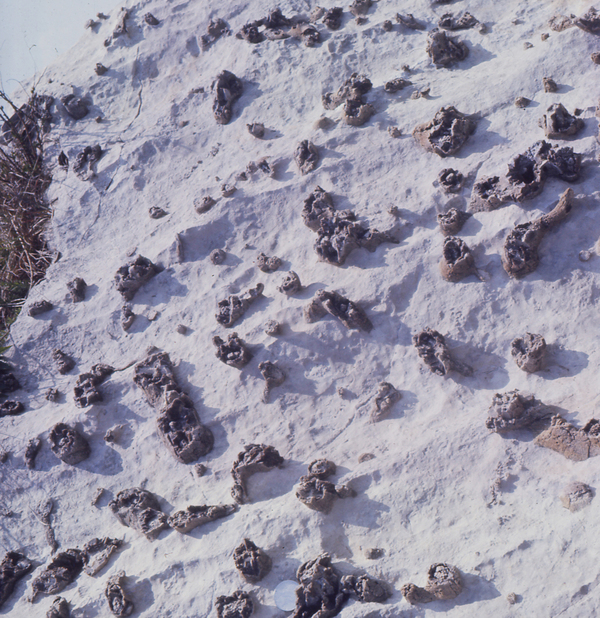
The nonnococco ooze forming the Maiolica, may be locally enriched in chert, originating from the locally abundant radiolarians.
On the Trento Plateau, this was the time of deposition for a well-known facies, the Rosso Ammonitico (in the Anglo-saxon literature curiously spelled Ammonitico Rosso). Polished stones from the quarries of the Venetian Prealps were largely used in churches and manors throughout Italy and elsewhere. Due to the mixing of facies and lithostratigraphic terms, Martire et al. (2006) proposed to define the formation as Rosso Ammonitico Veronese. In their review, they identified several members from upper Aalenian to Tithonian (Fig. 54). They include in the formation also the “Lumachella a Posidonia alpina Member” (Sturani, 1971), consisting of coarse-grained grainstone packed with thin-shelled bivalves, poor in micrite and with thick rims of isopachous cement (Martire et al., 2006). Most typical is the Rosso Ammonitico facies, subdivided in three members—lower, middle, and upper. The lower member is an amalgamated pseudonodular, pink packstone-mudstone, apparently massive in outcrop (age: late Bajocian to lowermost late Callovian). It thins out northwards, where it lies directly on the Dolomia Principale (Fig. 55). The middle member, a few m thick, consists of thin-bedded nodular limestone with red chert nodules and beds (age: late Callovian to middle Oxfordian). toward the Belluno Basin, this member interfingers with a grey, cherty limestone, including resedimented ooidal and peloidal grainstone, which forms the Calcare Selcifero di Fonzaso (Beccaro et al., 2008). The Rosso Ammonitico Superiore consists of nodular, marly limestone with a knobby, weathering surface (age: middle Oxfordian to late Tithonian). toward the top, the formation gradually loses its pink colour and passes to the whitish, thin-bedded wackestone of the Maiolica Fm. (Biancone Fm. in the local terminology). This member reaches the thickness of about 15 m in its type-section, while on the whole the total thickness of the formation is about 30 m. The Rosso Ammonitico Veronese therefore has a sedimentation rate around 1 m/My, with frequent gaps and indurated surfaces. Winterer (1998) made an exercise to estimate the depth of deposition in the Middle and Upper Jurassic on the Trento Plateau and produced a figure around 100 m in depth at the beginning of the Rosso Ammonitico Veronese, reaching about 400 m at the end with the Maiolica deposition. These figures account for a sea floor initially swept by currents forming the Posidonia alpina lumachelle, followed by a deeper floor reached by planktonic carbonatic rain, partly dissolved during the long time resting before burial. The cherts of the middle member record the blossom of radiolarians during the southern loop of Adria during the Middle Jurassic.
Figure 54. Rosso Ammonitico Veronese.
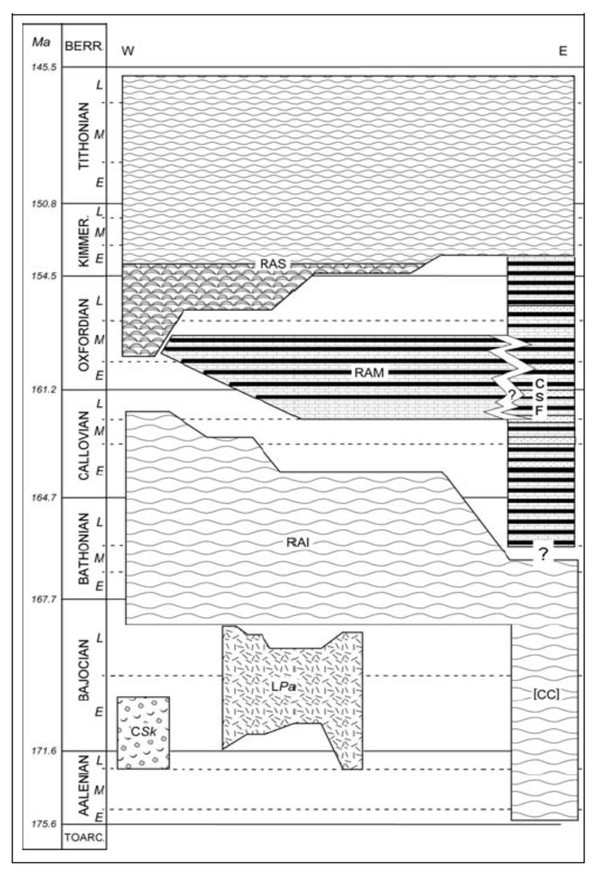
The stratigraphic scheme of the Rosso Ammonitico Veronese on the Trento Plateau (From Martire et al., 2006).
Figure 55. The Rosso Ammonitico Veronese onlaps.
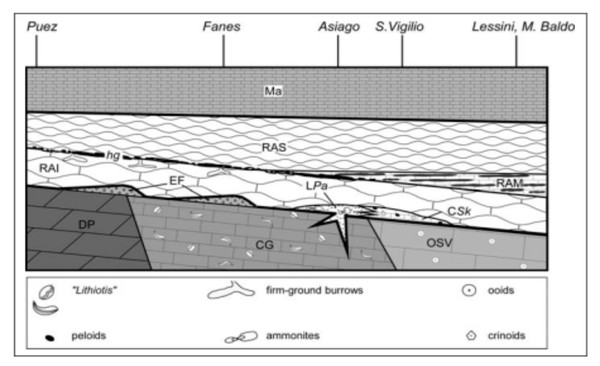
The Rosso Ammonitico Veronese onlaps northwards on progressively older units. (From Martire et al., 2006).
The Belluno Basin records the unusual feature of a thick unit, the Vaiont Limestone—up to 500 m thick, consisting of oolitic and skeletal grainstone. This typical shallow-water facies is interbedded in a pelagic sequence. Bosellini and Masetti (1972) first recognized the resedimented nature of the oolites, originating from the nearby Friuli Platform, and forming a wide apron infilling this Jurassic “Tongue of the Ocean” (Bosellini et al., 1981) (Fig. 56) (age: late Bajocian to Bathonian; Clari and Masetti, 2002). When oolitic resedimentation was over, pelagic sedimentation resumed with cherty mudstone and interbedded turbiditic layers of the Fonzaso Fm. Its age, from Callovian to early Kimmeridgian, matches the radiolarian blossom, already discussed within the Lombardian Basin. The deep-sea sedimentation graded into a facies similar to the upper member of the Rosso Ammonitico Veronese, then it passed gradually, toward the end of the Tithonian, to the Maiolica whitish mudstones (Fig. 57).
Figure 56. The “Tongue of the Ocean”.
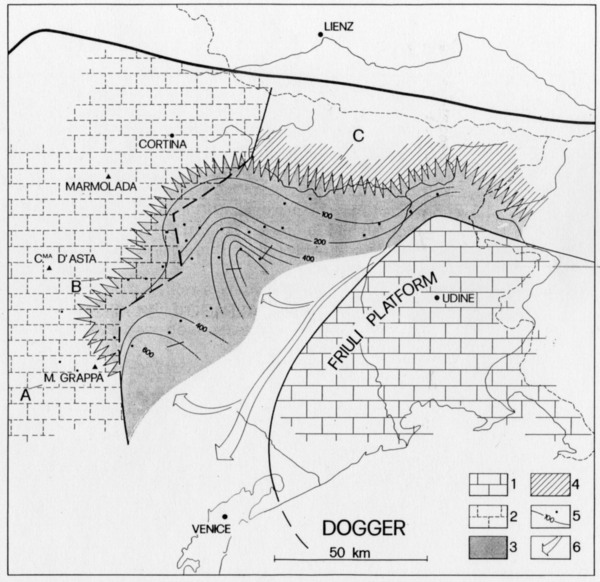
The Belluno Basin had the size in its outcropping part, like the present Tongue of the Ocean in the Bahama Banks. 1. Platform limestone. 2. Red nodular pelagic limestone (Rosso Ammonitico Veronese). 3. Oolitic turbidites (Vajont Limestone). 4. Siliceous basinal limestone (Fonzaso Fm.) 5. Isopachs (in m). 6. Inferred longshore currents. (From Bosellini et al., 1981).
Figure 57. Belluno Basin.
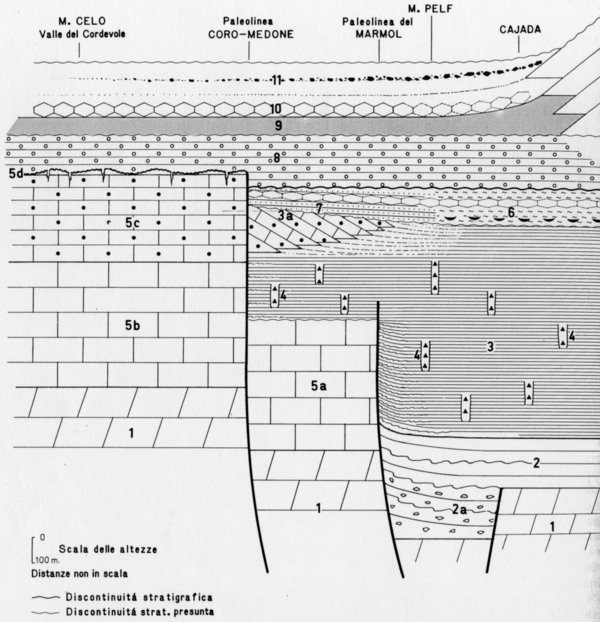
Stratigraphic scheme for the Belluno Basin. 1. Dolomia Principale. 2. Schiara Dolomite. 2°. Schiara Dolomite, Marmol breccias. 3. Soverzene Formation. 3°. Soverzene Fm. calcarenitic member. 4. Pelf breccia. 5°, b, c, d, members inside the Calcari Grigi Fm. 6. Igne Formation. 6°. Igne Fm. black shale. 6b. Igne Fm. nodular limestone in Rosso Ammonitico facies. 7 Erbandoli calcarenite. 8. Vajont Limestone. 9. Fonzaso Formation. 10. Rosso Ammonitico Veronese. 11. Maiolica. (From Masetti and Bianchin, 1987).
On the Friuli Platform, the oolite factory was fully active to be able to export the huge amount of material transferred into the Belluno Basin to form the Vaiont Fm. During the Oxfordian and early Kimmeridgian, coral and Ellipsactinia reef, cropping out in the Cansiglio - M. Cavallo area, bounded the platform (Sartorio, 1987; Cati et al., 1987). After this episode, the margin, formed mainly by sandy shoals, prograded toward the basin. The internal platform facies, spread with mudstone to packstone of the Cellina Limestone, persisted up to the earliest Aptian (Cati et al., 1987; Venturini, 2002). It should be noted that boreholes indicate that inside the Friuli Platform persisted a deeper area oriented NW-SE (Cati et al., 1987).
